Ants are one of a beekeeper's most common pests, both in the apiary and in the honey house. Florida and the southeastern United States have a large and diverse ant fauna, with both native and exotic species. The vast majority of ant species have no impact on our bees or us. The few pest species can cause serious problems. We can divide the ants into two pest groups, bee and brood eaters and honey and nectar stealers. Some species can cause both problems at times.
The Bee and Brood Eaters
black carpenter ant—Camponotus pennsylvanicus
compact carpenter ant—Camponotus planatus
Florida carpenter ants—Camponotus floridanus and C. tortuganus
crazy ant—Paratrechina longicornis
crazy ant—Nylanderia bourbonica
tawny crazy ant—Nylanderia fulva
bigheaded ant—Pheidole megacephala
red imported fire ant—Solenopsis invicta
little fire ant—Wasmannia auropunctata
The Honey and Nectar Stealers
Argentine ant—Linepithema humile (formerly Iridomyrmex humilis)
ghost ant—Tapinoma melanocephalum (called black-headed ants in California)
white-footed ant—Technomyrmex difficilis
Pharaoh's ant—Monomorium pharaonis
The most prominent ants that people notice are the carpenter ants. These are some of our largest ants and are abundant in both suburban and rural locations. Many Floridians call these bull ants because of their large size. The eastern or Florida harvester ant, Pogonomyrmex badius, is also called the "bull ant," but they can deliver a wicked sting. Carpenter ants cannot sting, but they do deliver a slicing bite into which they spray formic acid. There are numerous species in Florida. These ants are omnivorous, eating honeydew, nectar, honey, other insects, and carrion. The most widespread and common is the Florida carpenter ant. The head and thorax are reddish and the abdomen is black. These ants do not excavate wood but nest in voids. Vacant bee equipment is a favorite nesting location. They will commonly nest between the inner and outer covers. These ants generally won't raid healthy colonies, but will raid weakened colonies for honey, brood, wax moth larvae, and uncapped nectar.
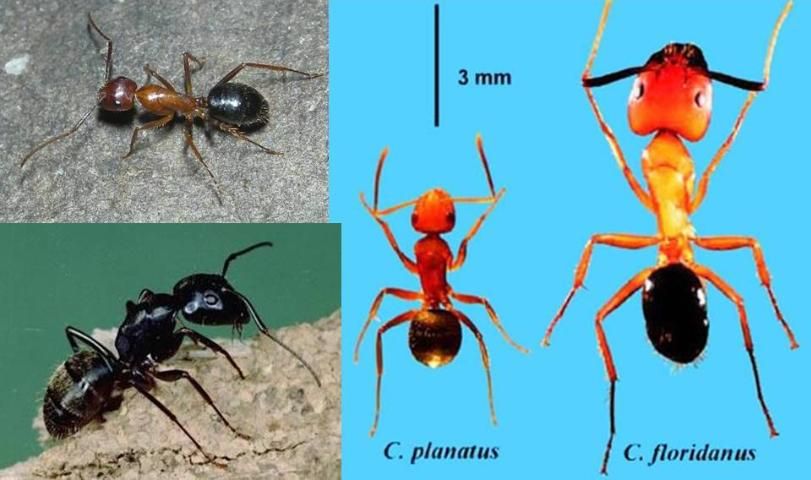
Credit: William Kern, UF/IFAS (Florida carpenter ant); Rudolf H. Scheffrahn, UF/IFAS (comparison of workers of the compact carpenter ant and the Florida carpenter ant); Clemson University, USDA Cooperative Extension Slide Series, Bugwood.org (black carpenter ant)
In the Florida Panhandle and most of eastern North America, we have the black carpenter ant, Camponotus pennsylvanicus. These ants will excavate wood softened by fungal wood rots. Another species that was introduced into south Florida is the compact carpenter ant, Camponotus planatus. The compact carpenter ant is diurnal (active during the day) while the other carpenter ants are more nocturnal (active at night). It is solid brown in color. Although they are smaller than our native carpenter ants, I have had more problems with compact carpenter ants in south Florida than any other ant species. They have excavated into the wood of both lids and supers and have even taken over nuc boxes. Carpenter ants tend to be polymorphic (many sizes of workers). While carpenter ants will take sugar baits on occasion, protein-based baits are generally better accepted.
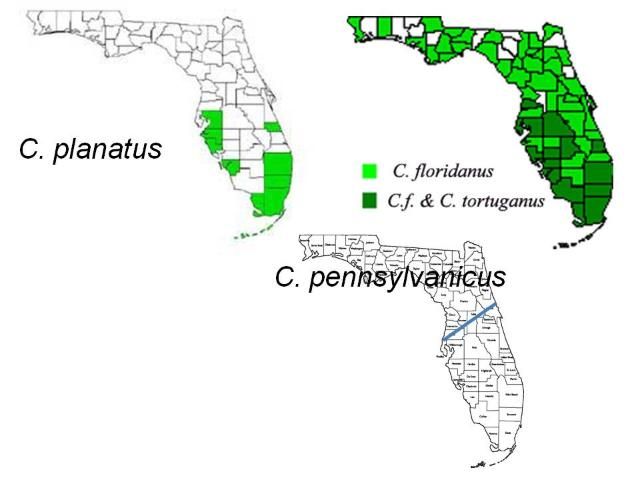
The crazy ants, Paratrechina longicornis, Nylanderia bourbonica, and the tawny crazy ant, Nylanderia fulva, get their name from their very fast movement made possible by their very long legs. Paratrechina longicornis and Nylanderia bourbonica have moderate sized colonies from a few hundred to a few thousand workers. The tawny crazy ant, Nylanderia fulva, is a much more serious problem due to their much larger colonies. These ants are in the formic acid ant subfamily (Formicinae), so they spray formic acid as a defensive chemical rather than having a stinger. They will take either sugar or protein-based baits.
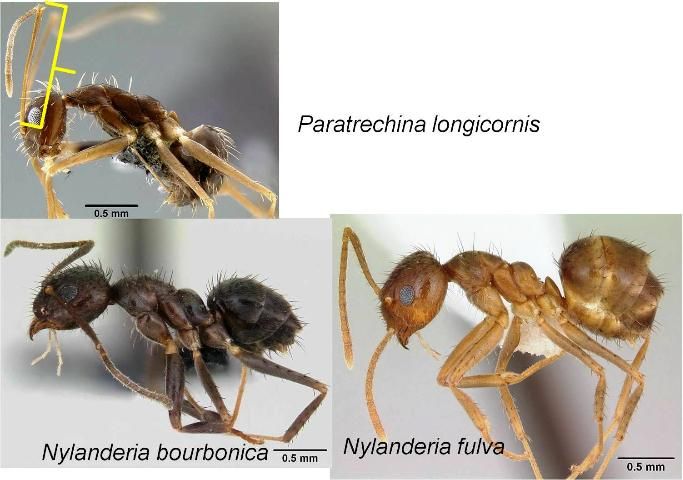
Credit: http://antkey.org/
Another exotic invader is the pan-tropical bigheaded ant, Pheidole megacephala. Their colonies are hunting machines. These ants nest in the soil and send out foraging columns to find insects and other small animals to dismember and carry back to the colony. Normally they will be happy with carrying off dead bees from the entrance and small hive beetle larvae that leave the hive to pupate in the soil. If a hive becomes very weak, they will go inside the hive and carry off bee brood, small hive beetle larvae, and wax moth larvae. They are most susceptible to protein-based ant baits.
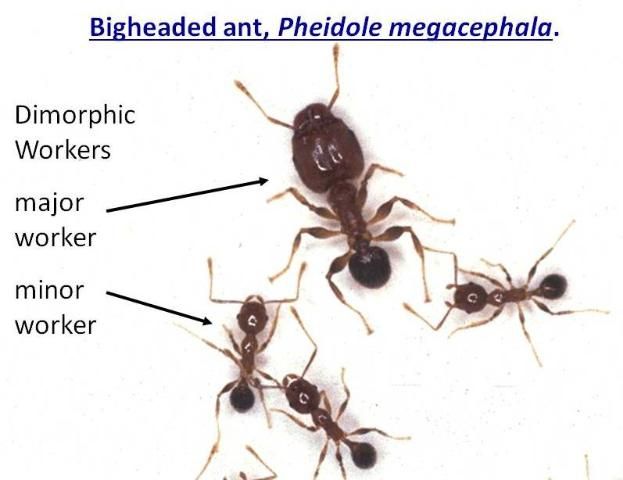
Credit: William H. Kern, UF/IFAS
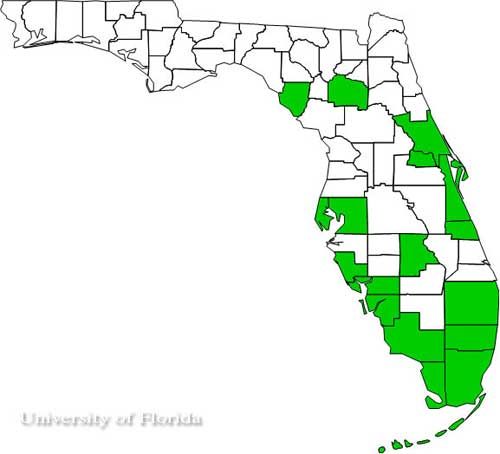
Credit: Warner and Scheffrahn (2007)
Of course, the most famous ant in Florida is an invader from South America, the red imported fire ant, Solenopsis invicta. Fire ants are known for their sting and the blister it causes. They will forage on insects, seeds, carrion, and even fruits like strawberries, peppers, etc. They have polymorphic workers (many sizes of workers in the same colony) and usually one queen per colony. My experience with them living under hives protected by ant guards has generally been positive. They much prefer foraging for small hive beetle larvae in the soil and dead bees on the ground than invade a healthy hive. I have lost several swarms placed in nucs due to red imported fire ants, and weakened hives are susceptible to their predation. Natural predators from South America, the decapitating Phorid fly, and fire-ant-specific pathogenic fungi and viruses have been introduced and may help keep fire ant populations to a reasonable size in the future.
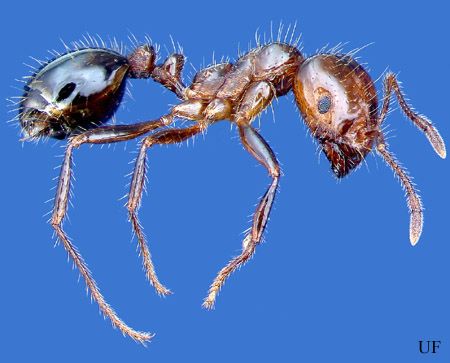
Credit: David Almquist, UF/IFAS
The little fire ant, Wasmannia auropunctata, was introduced from South America and now occupies most of the Florida peninsula. It has become a major problem for Hawaiian beekeepers since its 1999 introduction into Hawaii. These small ants (1.5 mm, the thickness of a US penny) are two-node ants and have a wicked sting.
![Figure 7 Figure 7. Little fire ant (Wasmannia auropunctata [Roger]) workers. Reddish to almost orange with strongly sculptured head and thorax.](/image/IN1181/2479919/7997124/7997124-2048.webp)
Credit: UF/IFAS
The Argentine ant, Linepithema humile (formerly Iridomyrmex humilis) is a medium-sized, dull brown ant with a single-node waist. They are generally seen in large foraging columns. These are formic acid ants like carpenter ants and crazy ants. This is one of the ant species reported to form super colonies that can be hundreds of kilometers across. Their large colony size and love for sugars can be devastating to bee hives if hives are not protected by effective ant guards. They are best controlled with sugar-based liquid baits.
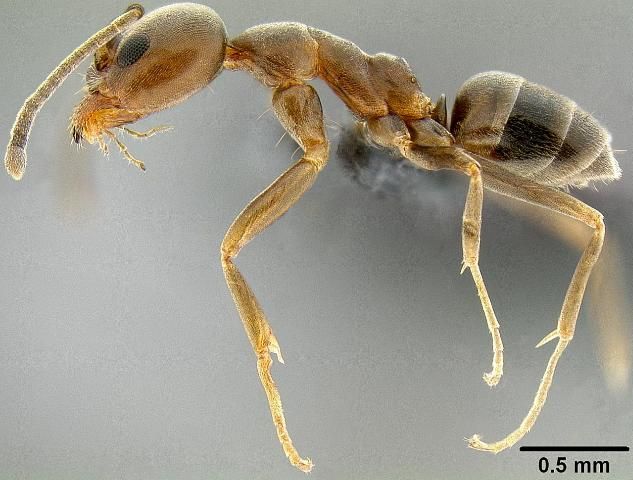
Credit: http://itp.lucidcentral.org/id/ant/pia/Fact_Sheets/Linepithema_humile.html
The ghost ant, Tapinoma melanocephalum, is another invasive ant species from either Africa or Asia. They are tiny, 1.3 to 1.5 mm long, or the thickness of a US dime or penny. Their coloration also makes them look smaller than they truly are. On a light-colored surface you mostly see the head and thorax, while on a dark surface you mostly notice the abdomen and legs. In either situation, the ant appears half the size it really is. They are also monomorphic, which means that all the workers in a colony are the same size. Several times I have seen an entire colony of these ants nesting on the top bar of a frame under the cover. These are sugar-loving ants, feeding on honeydew, nectar, honey, and any sugar-containing liquid inside houses. They can be a serious nuisance in the honey house. The defensive pheromone of the ghost ant is composed of 6-methyl-5-hepten-2-one and actinidine. When these ants are crushed, they give off a banana oil smell, or some people describe it as smelling like a piña colada. The 6-methyl-5-hepten-2-one is structurally very similar to the honey bee alarm pheromone component isopentyl acetate (see Figure 7). This may explain why these ants upset a bee colony when the ants are disturbed or crushed.
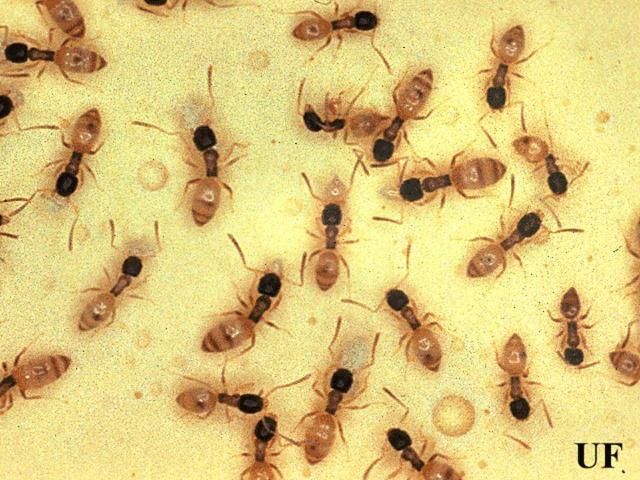
Credit: J. L. Castner, UF/IFAS
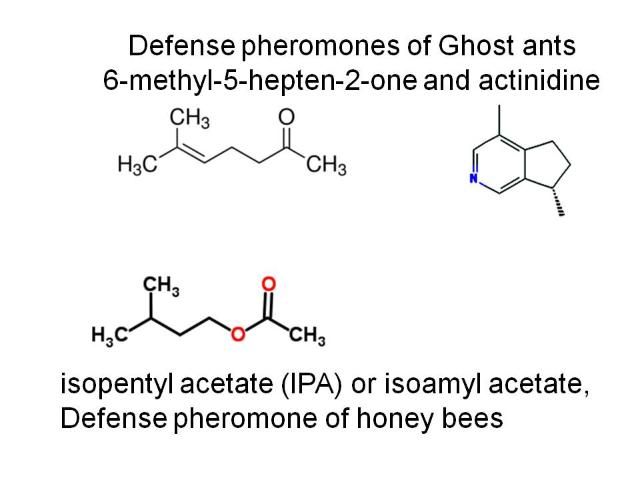
The white-footed ant, Technomyrmex difficilis, is originally from southeast Asia. These ants are about 3 mm long, the thickness of 2 US pennies. These are tree-dwelling ants that can develop into colonies of over one million workers. They have an unusual reproductive system compared to most ants. There are three reproductive types of females in a WFA colony, typical winged queens and two non-winged forms that are called intercastes. The numerous queens and intercastes all lay viable eggs and make up as much as 40% of the colony. A small colony of 100,000 WFA would have about 40,000 females laying eggs. These ants are best controlled with numerous bait stations containing sugar-based liquid bait. A large colony can remove up to a gallon (4 liters) of liquid bait every 2–3 days, requiring regular replacement.
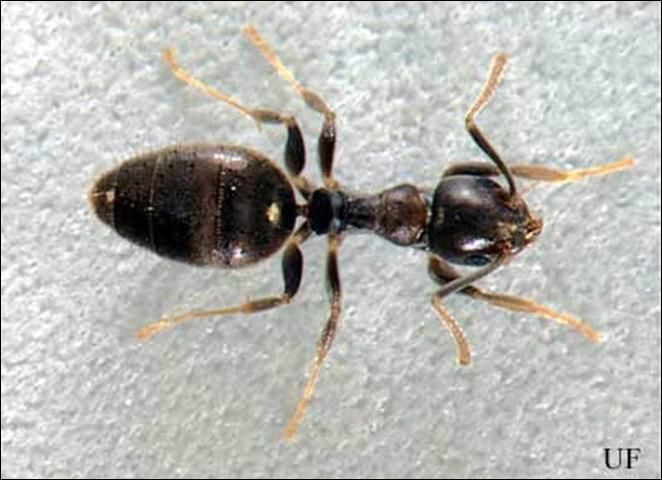
Credit: R. H. Scheffrahn, UF/IFAS
The Pharaoh ant, Monomorium pharaonis (Linnaeus) is one of our most troublesome structural pest ant species. The workers are brown and 1.5–2.0 mm long (between the thickness of a US penny or nickel). These ants have a two-node waist and a spatula-shaped stinger that can't penetrate human skin, so they can't sting you. These ants are more likely to be a pest in the honey house than in the apiary. These ants are reported to be native to northern Africa, but because they have been carried all over the world by human commerce, it is impossible to identify their origin. Pharaoh ants are omnivorous and are reported to change their diet preferences (sugar, proteins, oils/fats) based on the needs of the colony. Often sugar (honey or corn syrup), oil (peanut butter oil or butter/ margarine), and protein-based baits (liver baby food, piece of hot dog, or Vienna sausage) are offered on a choice card to see which bait will work best.
![Figure 12 Figure 12. Pharaoh ant worker (Monomorium pharaonis [Linnaeus]). The roughness of the head and thorax differs from the shiny cuticle seen in fire ants. They have a two-segmented waist (pedicel) and a stinger, but the stinger is ineffective against human skin.](/image/IN1181/2479919/12404709/12404709-2048.webp)
Credit: Jim Kalisch, University of Nebraska-Lincoln
Important Facts about Ants
Adult ants can only ingest liquids. They cannot eat solid food. The sieve plate in the back of their mouth/throat will only allow liquids to pass through. This has an impact on the effectiveness of various types of bait. Liquid baits are easier to ingest than gel baits, which are easier than solid baits. Granular baits are chewed by the ants, to remove the toxicant-containing oils, or saliva dissolves the soluble bait components and toxicant, and this liquid is then swallowed.
Baits
Carnivorous and scavenger ants like bigheaded, fire, and carpenter ants prefer proteins and fats/oils, while sugar-loving ants like ghost, white-footed, and Argentine ants readily go to sugar-based baits. Baits are universally considered the best option for ant control. The ideal bait has an attractive food-based matrix and the active ingredient (the poison) is non-repellent and slow acting, so it can be distributed throughout the colony before the foragers start to die. Pest control professionals who aren't sure which ant they are dealing with can use a choice card with liver baby food (protein), peanut butter (oils), and honey or sugar syrup. Whichever option the ants most prefer is the bait type you should use or use multiple baits.
Baits used outdoors should be inaccessible to people, pets, wildlife, and non-target pollinators. Commercial or home constructed bait stations are the easiest way to accomplish this.

Credit: William H. Kern, UF/IFAS
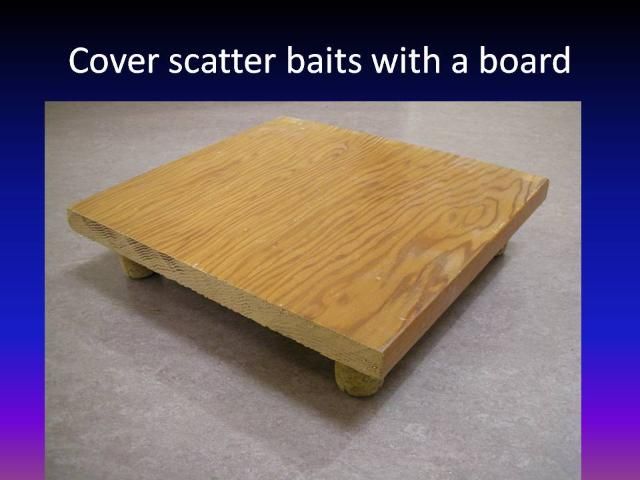
Credit: William H. Kern, UF/IFAS
Exclusion
Exclusion has long been the preferred method of ant control. Beekeepers have used ingenious methods of keeping ants out of beehives. Ant stands can be purchased or made. Usually they involve either a moat or a sticky barrier. The moat usually contains water and dish soap or detergent. In dry locations, fine dust like talc or amorphous silica gel dust are used in the moats. The dust coats the ant's feet and they are unable to climb out of the moat and die.
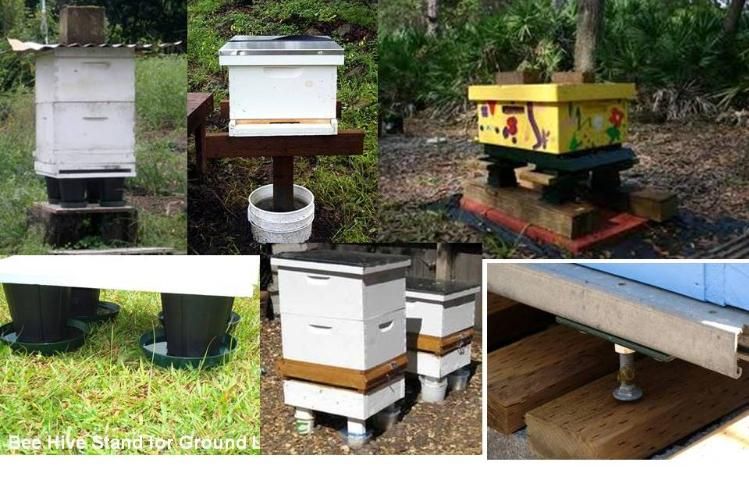
Credit: William H. Kern, UF/IFAS
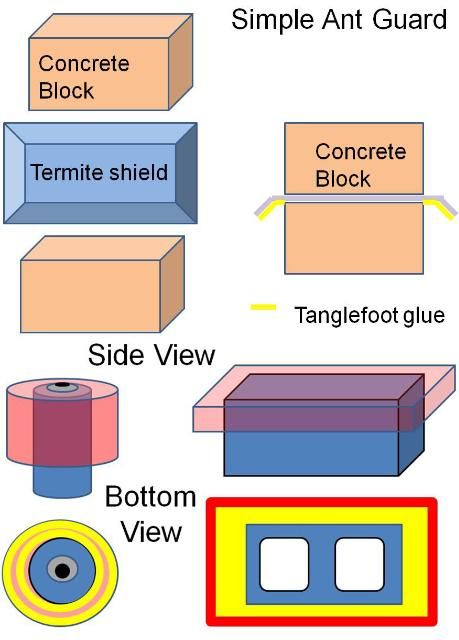
Non-drying, sticky materials like synthetic isoparaffinic hydrocarbon or organic mixtures (castor oil, waxes, and resins) are available commercially as barrier materials. Axial grease or wheel-bearing grease has been used in the past, but is not recommended because of potential environmental contamination. Some of the commercial organic mixtures are even approved for organic production.
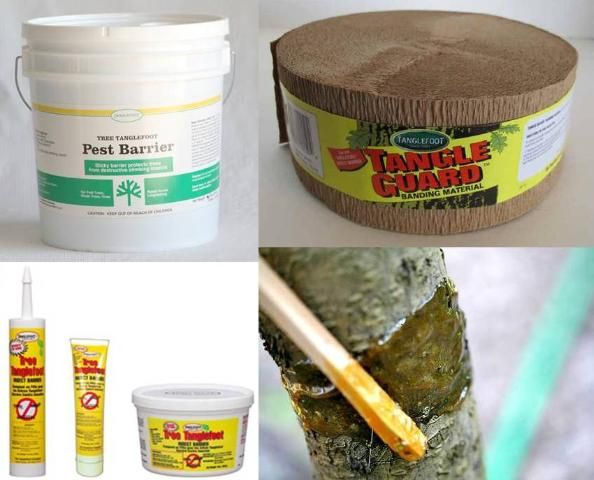
Credit: William H. Kern, UF/IFAS
Weed Control
The best-built and most expensive ant guard will cease to be effective if weeds touch the hive above the ant barrier. The ants use weeds as a ladder that allows them to get around the barrier. Control weeds with weed cloth under the hives, herbicides, mowing, string trimmers, solarization, hand cutting, and flame treatments.
Additional References
Shawn Brooks and J.C. Nickerson. 2014. Little fire ant, Wasmannia auropunctata. EENY-139. Gainesville: University of Florida Institute of Food and Agricultural Sciences. http://entnemdept.ufl.edu/creatures/urban/ants/little_fire_ant.htm
Laura Collins and Rudolf H. Scheffrahn. 2013. Red imported fire ant, Solenopsis invicta. EENY-195. Gainesville: University of Florida Institute of Food and Agricultural Sciences. http://entnemdept.ufl.edu/creatures/urban/ants/red_imported_fire_ant.htm
Betty Ferster, Mark Deyrup, and Rudolf H. Scheffrahn. The Pest Ants of Florida. UF/IFAS Fort Lauderdale Research and Education Center, Davie, FL.
J.C. Nickerson and C.L. Bloomcamp. 2012. Ghost ant, Tapinoma melanocephalum. EENY-310. Gainesville: University of Florida Institute of Food and Agricultural Sciences. http://entnemdept.ufl.edu/creatures/urban/ants/ghost_ant.htm
J.C. Nickerson, D. L. Harris, and T.R. Fasulo. 2014. Pharaoh ant, Monomorium pharaonis. EENY-290. Gainesville: University of Florida Institute of Food and Agricultural Sciences. http://entnemdept.ufl.edu/creatures/urban/ants/pharaoh_ant.htm
Shweta Sharma, John Warner, and Rudolf H. Scheffrahn. 2014. Tawny crazy ant (previously known as Caribbean crazy ant) Nylanderia (formerly Paratrechina) fulva (Mayr). EENY-610. Gainesville: University of Florida Institute of Food and Agricultural Sciences. http://entnemdept.ufl.edu/creatures/urban/ants/tawny_crazy_ant.htm
John Warner and Rudolf H. Scheffrahn. 2013. Bigheaded ant, Pheidole megacephala. EENY-369. Gainesville: University of Florida Institute of Food and Agricultural Sciences. http://entnemdept.ufl.edu/creatures/urban/ants/bigheaded_ant.htm
John Warner and Rudolf H. Scheffrahn. 2014. Compact carpenter ant. EENY-189. Gainesville: University of Florida Institute of Food and Agricultural Sciences. http://entnemdept.ufl.edu/creatures/urban/ants/C_planatus.htm
John Warner and Rudolf H. Scheffrahn. 2014. Florida carpenter ant, bull ant, Tortugas carpenter ant. EENY-272. Gainesville: University of Florida Institute of Food and Agricultural Sciences. http://entnemdept.ufl.edu/creatures/urban/ants/fl_carpenter_ants.htm
John Warner, Rudolf H. Scheffrahn, and Brian Cabrera. 2010. White-footed ant, Technomyrmex difficilis. EENY-273. Gainesville: University of Florida Institute of Food and Agricultural Sciences. http://entnemdept.ufl.edu/creatures/urban/ants/white-footed_ant.htm
David Westervelt. 2009. Pest Alerts - Argentine Ant, Liniepithema humile Mayr. Apiary Inspection, Florida Department of Agriculture and Consumer Services, Division of Plant Industry. http://www.freshfromflorida.com/Divisions-Offices/Plant-Industry/Plant-Industry-Publications/Pest-Alerts/Pest-Alerts-Argentine-Ant-Liniepithema-Humile-Mayr-Hymenoptera-Formicidae
Tables
Commercially available ant baits. This list is likely not complete, and any products missing from this list were not omitted deliberately. Those products listed are only for illustrative purposes and do not imply any endorsement, warranty, or recommendation by UF/IFAS. Manufacturers add and discontinue products, so this list will not be permanently accurate and should only be used as one possible guide to available products.